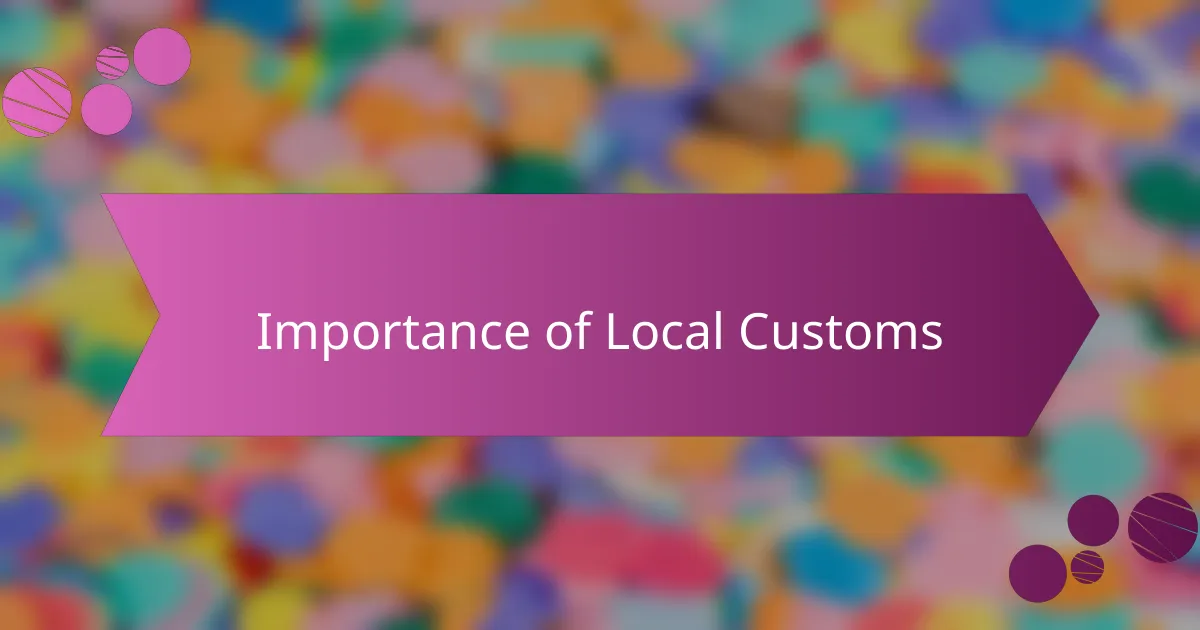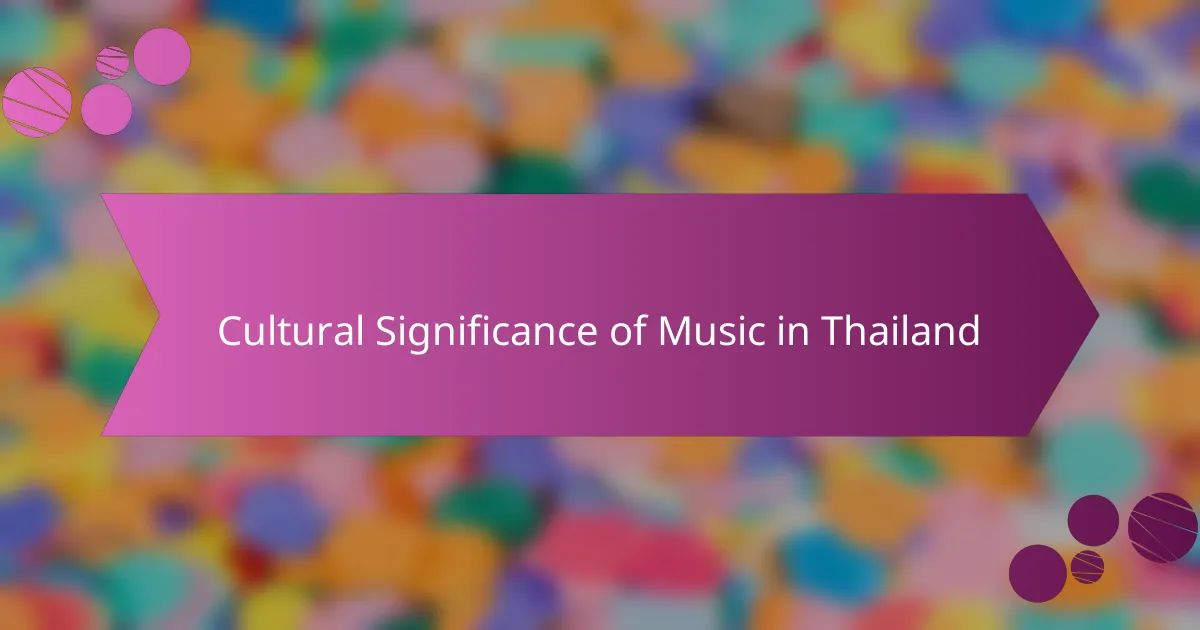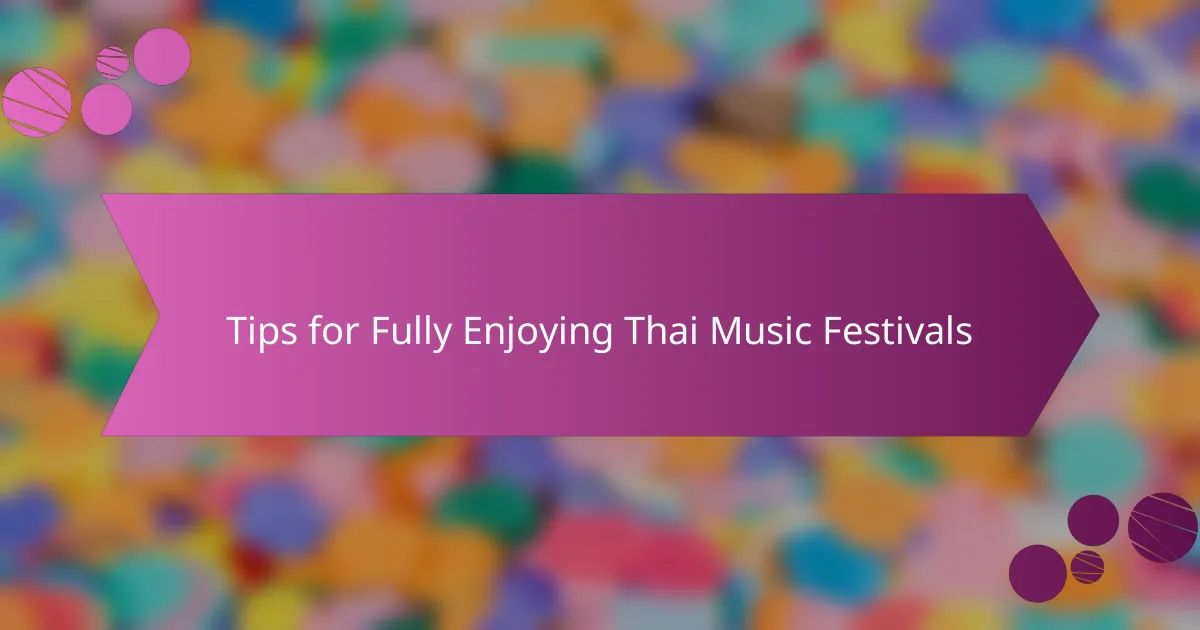Key takeaways
- Thai music festivals showcase a blend of traditional and contemporary music, featuring unique instruments like the Khim and Ranat.
- Participating in local customs, such as the wai greeting and traditional dances, enhances the festival experience and fosters connections.
- The festivals serve as a celebration of community, with food stalls offering traditional dishes and opportunities for shared enjoyment.
- Music in Thailand is a vital part of cultural identity, embodying stories, emotions, and historical significance that unite people across generations.

Understanding Thai Music Festivals
Thai music festivals are a vibrant reflection of the country’s rich cultural tapestry. Each festival showcases not just music, but also the deeply rooted customs and traditions that resonate with the local people. I remember attending the Songkran Music Festival, where the joyous atmosphere blended traditional Thai melodies with contemporary beats, illustrating a beautiful harmony between the old and the new.
- Festivals often feature unique instruments like the Khim (a zither-like string instrument) and the Ranat (a wooden xylophone).
- Attendees immerse themselves in local customs, such as the merit-making rituals that begin many celebrations.
- Food stalls at these festivals serve traditional dishes like Pad Thai and Som Tum, creating a feast for both the ears and the palate.
- These events encourage community involvement, bringing together families and friends to celebrate through music and dance.

Importance of Local Customs
Local customs play a vital role in enriching the experience of attending any festival, especially at a cultural hub like a Thai music festival. During my first visit, I was instantly drawn to the traditional wai greeting, which reflects the respect and warmth embedded in Thai culture. It’s heartwarming to see how these gestures of appreciation not only foster connections among attendees but also create a sense of belonging that transcends geographical boundaries.
As I engaged with local performers, I discovered that their music also enshrines these customs; every note seemed to echo the stories and values of their communities. These customs infuse the festival with a unique charm, making it more than just an event—it becomes a celebration of shared heritage and identity.
- Local customs promote cultural understanding and respect.
- They create a welcoming environment, encouraging attendees to connect.
- Customs offer insights into the history and values of the community.
- Participating in local traditions enhances the overall festival experience.
- Authentic interactions stemming from these customs foster lasting memories.

Key Features of Thai Music Festivals
Thai music festivals are a sensory feast, bursting with unique features that set them apart. For instance, I remember the moment I heard the enchanting sound of the Khim amidst the lively chatter of festival-goers. It was not just music; it was a connection to the past. The blend of ancient tunes with modern rhythms creates a captivating atmosphere that is truly one-of-a-kind.
What struck me most were the food stalls, where delicious aromas of Pad Thai and Som Tum wafted through the air. It’s hard not to feel excited when you see families gathered around, sharing stories over plates of vibrant dishes. These moments highlighted how food and music weave together to create a celebration of community. It made me wonder: how often do we get to taste the culture we’re immersed in?
The sense of unity at these festivals is palpable. I vividly recall joining a circle dance, surrounded by both locals and fellow travelers—it felt like we were all part of something bigger. This camaraderie enriches the festival experience, reminding us that music, food, and customs can connect people from all walks of life, creating cherished memories that last long after the final note fades.

Cultural Significance of Music in Thailand
Music in Thailand isn’t just entertainment; it’s woven into the very fabric of Thai culture. From my experience at a local festival, the sound of traditional instruments filled the air, creating an atmosphere that connected us all. I remember dancing with locals, sharing smiles, and feeling an unspoken bond as the rhythms of the music united people from various backgrounds.
Throughout history, music in Thailand has played a vital role in rituals and celebrations. It serves to honor deities, mark life milestones, and even tell stories that have been passed down for generations. This deep-rooted significance reveals how Thai music goes beyond sound—it’s a form of storytelling, community building, and cultural pride.
- Traditional Thai music often reflects the emotions of the people, whether it’s joy during celebrations or sadness in mourning.
- Instruments like the khim and ranat are not just tools; they symbolize cultural heritage and craftsmanship.
- Many festivals, such as Loy Krathong and Songkran, incorporate music to enhance the celebratory atmosphere and foster communal spirit.
- Thai music can bridge gaps between generations, allowing the youth to connect with their cultural roots through song and dance.

Personal Experiences at Thai Music Festivals
Attending Thai music festivals has been a life-changing experience for me. I vividly remember my first festival—walking through the vibrant stalls, sampling street food, and feeling the warmth from the locals who shared their culture with such pride. The rhythms of traditional Thai music intertwined with contemporary beats created an atmosphere that sparked joy and connection among everyone present.
Each festival I’ve attended introduced me to new customs and traditions. Here are some of the highlights that truly touched my heart:
- Participating in the lantern release ceremony, where hopes and wishes floated into the night sky, felt incredibly freeing.
- Learning traditional dance moves from local artists was not only enjoyable but also deepened my appreciation for the cultural history behind the music.
- Interacting with local musicians gave me insight into their inspirations and struggles, making the music resonate on a more personal level.
- Sharing laughter and stories over delicious Khao Soi with fellow festival-goers fostered a sense of community that felt both intimate and celebratory.

How to Respect Local Traditions
Respecting local traditions can greatly enhance your experience at a Thai music festival. During my first visit, I quickly learned the importance of bowing slightly when greeting locals. This gesture shows humility and respect, something that resonated deeply with me amidst the vibrant music and cultural atmosphere.
Another tradition is dressing appropriately, especially in temples or during local ceremonies. I remember feeling out of place in casual clothes at a festival, while others wore beautiful traditional outfits. It made me appreciate their culture even more and inspired me to embrace the local customs.
Here’s a comparison of common respect practices at Thai festivals:
| Local Custom | Importance |
|---|---|
| Bowing while greeting | Shows respect and humility |
| Wearing appropriate attire | Honors local traditions and beliefs |
| Participating in local rituals | Demonstrates appreciation and engagement |

Tips for Fully Enjoying Thai Music Festivals
When attending Thai music festivals, embracing local customs can enhance your experience immensely. I remember my first festival when I participated in a traditional dance with locals—it was a joyful and unifying experience. Being open to trying local foods and engaging with festival-goers in their native language can also create memorable moments that deepen your appreciation for the culture.
Another aspect I found particularly enriching was learning simple cultural gestures, like the “wai,” a respectful greeting. I made an effort to greet people this way, and it opened up conversations and connections that made the festival feel like a shared celebration rather than just an event. I highly recommend diving into these customs; it truly brings a special warmth to the atmosphere.
| Tip | Description |
|---|---|
| Participate in Local Customs | Try traditional dances or rituals to connect with the community. |
| Sample Local Food | Experiment with street food to indulge in authentic flavors. |
| Use the “Wai” Greeting | A simple gesture of respect that fosters friendly interactions. |
| Learn Basic Thai Phrases | Engage with locals by learning a few key phrases to enhance your interactions. |



